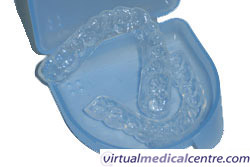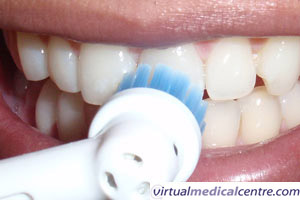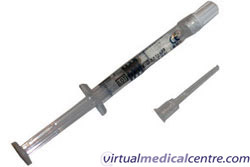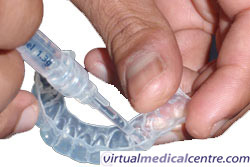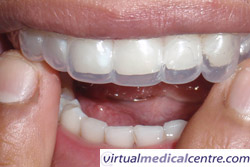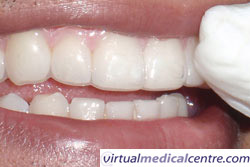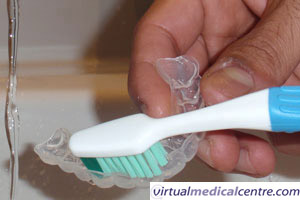What is home bleaching?

The bleach is usually carbamide peroxide, and has variable concentration levels. By and large, the higher concentration and thicker materials produce a lightening effect more quickly than lower concentration, less viscous materials. Higher concentrations are able to cause more sensitivity, and are tolerated for less periods of time usually. Thus, how bleaching impacts you lifestyle is important in determining what agents you can use and for how long.
You should be advised to keep syringes of the bleach in the fridge when not being used. Open syringes should be left outside to prevent further sensitivity due to the cold sensation of cold bleaching agents.
Home bleaching has the following advantages over other types of treatment:
- Very little time at the dentist;
- Usually much more financially affordable;
- You are able to bleach your teeth at your own convenience; and
- Some people may find the rubber dam or tissue dam very difficult to tolerate.
Disadvantages include:
- People have the responsibility of wearing the trays and completing the treatment themselves; and
- Many people like instant results and will want the treatment to take hours rather than weeks.
How home whitening is done
This is a general procedure for home bleaching:
- The dentist first conducts a full clinical examination and determines the cause of the discolouration. It should be decided if bleaching is the best method treatment for this patient, e.g. are veneers and crowns a better alternative?
- The dentist will take clinical photographs of how the teeth look before and after the treatment.
- Any fillings that have decay around them may be removed and replaced as a temporary measure because the colour of the teeth will change.
- A thorough scale and polish will be completed, especially on the teeth that are expected to get bleached.
- You will be asked to open your mouth wide, and the dentist will take some moulds to make the bleaching trays that will fit only to your mouth.
Note: bleaching trays that are fabricated after taking an impression and pouring a mould.
Information on re-publishing of our images
- You will be recalled after the trays have been made and they will be tried in your mouth to see how they fit. Your dentist will show you how to apply the bleaching material to the tray.
- You must pay particular attention to removing excess bleaching material from the gums with a cotton wool roll, toothbrush, cotton buds or finger as it can cause you gums to feel quite sore if you don’t.
- You will be given written instructions to take home with you including how to perform the procedure (it is best to brush and floss teeth prior to the applying the bleaching trays), the side effects, tray-wearing times and managing tooth sensitivity.
Note: it is important to brush your teeth before and after having home bleaching done to get the best results.Note: that you will purchase syringes containing bleach. These should be kept in a cool place. Note: open the syringe, and then load the tray. Only a small amount should be applied to minimise the amount of excess bleach used. The bleach should only be placed on the outside surface of the tooth, and on only those teeth that you want to bleach. Note: the tray is seated with the bleach inside, and the excess is removed with a wet tissue in this case.
The tray is left for the amount of time your dentist says.
Note: clean your tray well following each application with a brush and warm water.
Information on re-publishing of our images - Do not eat or smoke while applying the bleaching treatment.
- You should avoid smoking for two hours following the bleaching.
- Foods which have strong colours should also be avoided for 48 hours following treatment or consumed in moderation.
- You need to return to your dentist for review 10 days to two weeks following the treatment.
- The dentist will examine your mouth for any adverse effects.
- The dentist will assess if there has been some improvement by comparing what shade your teeth were before to what shade your teeth are now.
- The dentist will most likely tell you to continue using the bleaching trays for a few more weeks and a review appointment will me made for you 2-3 weeks later.
- The second review is the same as the first, except the dentist may take some pictures of your teeth to compare the difference. At this stage the dentist will probably tell you to touch up now and then, rather than using it every day.
Side effects of home whitening
The most common side effect is tooth sensitivity. About half the people who complete home bleaching report tooth sensitivity.
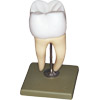 |
For more information, see Tooth Sensitivity (Dentine Hypersensitivity and Pulpal Disease) |
Another common problem may be some discomfort in the gums around the teeth due to the bleaching agent, or even improperly fitting bleaching trays.
For an unknown reason there is usually an increase in the health of the gums when people have whitening treatments done. This may be due to either an increase in oral health during times of bleaching due to increased attention on their teeth, or because the bleaching material is toxic to bacteria near the gums.
Kindly written by Dr Akhil Chandra BDSc. (Hons UWA)
Dentist, Whitfords Dental Centre and Editorial Advisory Board Member of the Virtual Dental Centre
More information
 |
For more information on various bleaching techniques for teeth, including home bleaching, assisted bleaching, power bleaching, the thermocatalytic technique and the walking bleach technique, see Teeth Whitening. |
References
- Sulieman M. An overview of bleaching techniques: 2. Night Guard Vital Bleaching and non-vital bleaching. Dent Update. 2005 Jan-Feb;32(1):39-40, 2-4, 6.
- Pretty IA, Ellwood RP, Brunton PA, Aminian A. Vital tooth bleaching in dental practice: 1. Professional bleaching. Dent Update. 2006 Jun;33(5):288-90, 93-6, 99-300 passim.
- Tam L. The safety of home bleaching techniques. J Can Dent Assoc. 1999 Sep;65(8):453-5.
- Leonard RH, Jr., Haywood VB, Phillips C. Risk factors for developing tooth sensitivity and gingival irritation associated with nightguard vital bleaching. Quintessence Int. 1997 Aug;28(8):527-34.
- Reinhardt JW, Eivins SE, Swift EJ, Jr., Denehy GE. A clinical study of nightguard vital bleaching. Quintessence Int. 1993 Jun;24(6):379-84.
All content and media on the HealthEngine Blog is created and published online for informational purposes only. It is not intended to be a substitute for professional medical advice and should not be relied on as health or personal advice. Always seek the guidance of your doctor or other qualified health professional with any questions you may have regarding your health or a medical condition. Never disregard the advice of a medical professional, or delay in seeking it because of something you have read on this Website. If you think you may have a medical emergency, call your doctor, go to the nearest hospital emergency department, or call the emergency services immediately.

